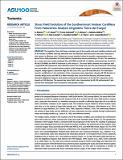Por favor, use este identificador para citar o enlazar a este item:
http://hdl.handle.net/10261/206244COMPARTIR / EXPORTAR:
 SHARE SHARE
 CORE
BASE CORE
BASE
|
|
| Visualizar otros formatos: MARC | Dublin Core | RDF | ORE | MODS | METS | DIDL | DATACITE | |

| Título: | Stress Field Evolution of the Southernmost Andean Cordillera From Paleostress Analysis (Argentine Tierra del Fuego) |
Autor: | Maestro González, Adolfo; Ruano, P.; Torres-Carbonell, Pablo; Bohoyo, Fernando CSIC ORCID ; Galindo-Zaldívar, Jesús; Pedrera Parias, Antonio CSIC ORCID; Ruiz Constán, Ana CSIC ORCID; González Castillo, Lourdes; Ibarra, P.; López Martínez, Jerónimo | Fecha de publicación: | 1-ene-2019 | Editor: | American Geophysical Union | Citación: | Tectonics 34 (1): 7-25 (2019) | Resumen: | The Argentine Tierra del Fuego comprises part of the roughly east-west trending southern end of the Andean Cordillera intensely deformed since the Mesozoic. Mesostructures have been measured in Late Jurassic to Miocene rocks. Taking into account statistical criteria to provide a representative stress tensor from a fault population, this study defines 28 paleostress tensors pertaining to 22 sites. The orientation of sigma(1) shows two main modes trending E-W to ESE-WNW and NE-SW. In addition, extensional sites reveal N-S, NE-SW, ESE-WNW, and NW-SE horizontal sigma(3) and vertical sigma(1). The stress fields obtained are congruous with a regional NE-SW compressive stress direction active in the study zone since the Late Cretaceous. Shortening was coeval with a 30 degrees counterclockwise rotation of the Patagonian orogenic curve and the indentation of the orogenic wedge against a basement high, the Rio Chico Arch, up to the early Miocene. The indentation caused a modification in the orientation of the compressive stress trajectories, showing NE-SW direction in Sorondo Range sector and NW-SE in Mitre Peninsula area. Since the late Miocene, left-lateral activity along the Magallanes-Fagnano Fault System produced local deviations of the NE-SW compressive stress toward an E-W direction. The present-day stress field is also characterized by NE-SW subhorizontal P axis derived from earthquake focal mechanisms and geodetic studies. | Versión del editor: | http://dx.doi.org/10.1029/2018TC005158 | URI: | http://hdl.handle.net/10261/206244 | DOI: | 10.1029/2018TC005158 | Identificadores: | doi: 10.1029/2018TC005158 issn: 0278-7407 |
| Aparece en las colecciones: | (IACT) Artículos (IGME) Artículos |
Ficheros en este ítem:
| Fichero | Descripción | Tamaño | Formato | |
|---|---|---|---|---|
| Tectonics 38 7.pdf | 11,2 MB | Adobe PDF |  Visualizar/Abrir |
CORE Recommender
SCOPUSTM
Citations
7
checked on 18-abr-2024
WEB OF SCIENCETM
Citations
7
checked on 24-feb-2024
Page view(s)
143
checked on 22-abr-2024
Download(s)
315
checked on 22-abr-2024
Google ScholarTM
Check
Altmetric
Altmetric
Este item está licenciado bajo una Licencia Creative Commons

